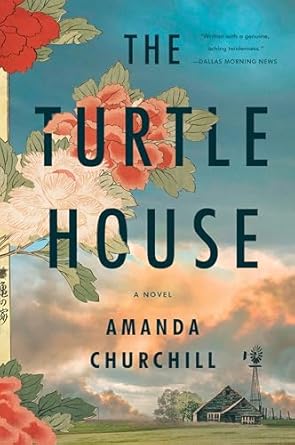The Turtle House by Amanda Churchill
The Turtle House is a poignant, potent and revelatory first novel written by Amanda Churchill. This historical work of fiction was inspired by the life of her grandmother whose shared memories and stories of fellow war brides were revealed to the author in a series of interviews. Her grandmother recounted their experiences during WWII in Japan and later when they married American servicemen stationed there as occupying forces. Amanda also conducted extensive research into the history of Japanese war brides through books, documentaries and travel.
Prominent fictional characters, Mae and baby brother Paulie, born to American airman James Cope and his Japanese wife Mineko, spent their early childhood living on the Tachiwara Air Base outside of Tokyo, Japan. The airfield had been built in 1922 by the Imperial Guard. Following the Japanese surrender on September 5, 1945 it was taken over by the US Army Air Corps, restored and served as a transport base until 1977. In real life, Amanda’s father was also born and lived on a military base in Japan with his parents until his father was honorably discharged from the service and the family returned to the United States.
A Story Rooted in History and Heartbreak
The Turtle House begins on March 1, 19,99 on Mineko Cope’s 73rd birthday as she sits with Lia, her 25-year-old granddaughter, who has persuaded her to reminisce about herself and her life in Japan before she married and moved to the family’s small, remote farm in rural NE Texas. Her grandfather James had died years before she was born and she was curious about how they met and what prompted them to marry. Lia has set up a small tape recorder between them and attempts to ask questions while chatting with her grandmother, who pauses for snacks and beverages while chain smoking Salem Light cigarettes. She initially displays reluctance to relate her life story in a coherent, linear fashion, although she is neither mentally nor physically impaired. Later, she will take the tape recorder and record her thoughts while alone in her room.
These two protagonists will share the narration, alternating between the present and the distant past. Mineko is pragmatic, outspoken without filtering her remarks, stoic and not demonstratively affectionate nor does she know Lia well as they had not spent much time together. Until her recent retirement, she worked for thirty years as a full-time nursing assistant in the Dennis State Home for Mental Impairment, most often on the night shift, where she was loved by both patients and staff for her genuine caregiving. The income provided the means for both of her children to attend college.
Both women are currently guests in Lia’s parents’ modest home. Last month, Mineko was thought to have accidentally burned down the 100-year-old wood-built family home she had lived in since coming to America with James. Her adult children, who also lived on the Cope land, suspected she was smoking in bed, but the fire investigators determined that old wiring was overloaded, overheated and ignited the blaze, which burned the place to the ground. Granddaughter Lia had completed her fifth and final year, earning her a B.A. in Architecture from the University of Texas and had landed a job with a prominent commercial design firm in Austin and was on track to take her Architect Registration Exam ahead of schedule.
Instead, her academic and private life collided, destroying her plans and confidence, causing her to flee in self-perceived disgrace home to her parents, unwilling to discuss the situation that caused her impetuous decision, which effectively “burned down her architecture career.”
Two Women, One Family, and the Weight of the Past
Mineko’s well-meaning children quickly come to realize it would be impossible to share a home with their mother and rapidly moved her into an upscale retirement home that doesn’t allow smoking or pets. Her semi-feral orange tabby Yoshi will have to be left behind with them. When Lia is not working her mind-numbing stopgap job at a gift shop, she can be found hanging out with her grandmother. Ultimately they develop sufficient trust to share their innermost longings and secrets.
A tomboy and her father’s favorite child growing up, Mineko was a disappointment to her mother, who doted on Hisako, her beautiful, feminine little sister. Hisako, behind their parents’ backs, taunted her plain sister with the hurtful nickname “Stump Face”. When not in school, she explored the countryside near their home and in 1936, at age 10, discovered her refuge and sanctuary. It was The Turtle House, an abandoned, overgrown, formerly grand manor decorated with stone-carved turtles at the corners of each overhanging eave. A large pond on the grounds was deep enough to comfortably swim in and daydream.
Among the reeds and weeds and resting atop stones in the water were several live turtles of varying sizes, which the little girl named and fed regularly with vegetable trimmings and old noodles. By happy chance, as a teenager, she met Akio Sato, the handsome firstborn son of a wealthy family and taught him to swim in that pond. Gradually, their instant camaraderie blossomed into love. Incredibly, to Mineko, her prince charming, Akio, after informing his parents of his intentions, broke off his long-ago arranged marriage plans and intended to wed Mineko after he completed his university studies. His status as a student and eldest son exempted him from military service.
Love, Loss, and the Legacy of The Turtle House
Imperialist Japan had been aggressively fighting the Sino-Japanese War by invading and occupying Manchuria from September 18, 1931, until the Soviet Union and Mongolia seized control and ousted the Japanese military in August 1945. They had established a puppet state they named Manchukuo with Puyi, the last emperor of China, as a figurehead. They also massacred as many as 300,000 Chinese during their 1937-1938 seizure and occupation of Nanking, China. The war with the Allied Powers that began after Japan’s December 7, 1941, bombing of Pearl Harbor caused Japan to face critical shortages of food, military equipment and manpower, which resulted in the discontinuation of familial and student draft exclusions.
Akio Sato was sent to an outpost in Manchuria, where he sent deceptively optimistic letters to Mineko and his parents until his death. At war’s end, widespread devastation from bombing raids remained and Mineko’s family home was barely habitable. Basic necessities, including food and medicines, were in short supply. The American occupying forces brought an infusion of strong, healthy men who were generous with money, food and a spirit of joie d’vivre that had been lacking for years. Jobs on or near the bases became available and highly sought after. Although impossible to enforce, the military discouraged fraternization between soldiers and local women. Faced with the reality of these relationships, gradual approval came for marriages and “Bride schools” were established for the new wives to learn English, American customs and cooking.
Mineko was able to assist her family after marrying James Cope. He was not the love of her life but after the birth of Mae and Paulie, she was determined to survive and provide for them. The first few years while living on Japanese soil were the easiest. There was a lively community of young Japanese wives on Tachiwara Air Base who were expected to keep their small government built houses tidy and their husbands happy while taking care of the babies that arrived before or after marriages. They accepted their new Americanized first names, struggled with the alien English language and attended various classes in order to facilitate their assimilation when their husbands were discharged and returned home. The couples had enjoyed cookouts, dances, movies, and bowling on base and if James sometimes drank too much, he would sleep it off before returning to work.
Tiny, dusty (and fictional) Curtain, Texas came as a shock. Racial prejudice and outright hatred from some Gold Star families who had lost sons or husbands in the Pacific were overly rude or unpleasant to Mineko. Years elapsed before the extended Cope family accepted her. Returning to his life as a farmer, James worked hard on the land but swiftly metamorphed into an unfaithful, brutish alcoholic who both verbally and physically abused Mineko. It came as a relief when cancer and a heart attack killed him in 1965. Resisting the temptation to return to Japan, she bore the pain and sacrifices made for her children and succeeded in raising two successful, well-respected All-American children with spouses and children of their own.
The conversations and tape recordings made with granddaughter Lia allow each of them to reveal their struggles as well as form an invincible bond. The Turtle House will live again on the creek banks on this Texas farm.
Amanda Churchill has written a sweeping saga of family dynamics and complex relationships while providing insights into the challenges facing the approximately 100,000 Asian women who became war brides post-WWII. It’s a masterful, enlightening first novel.
About Amanda Churchill:
 Amanda Churchill is a writer living in Texas. Her novel, The Turtle House, was inspired by the life of her beloved grandmother, a Japanese war bride.
Amanda Churchill is a writer living in Texas. Her novel, The Turtle House, was inspired by the life of her beloved grandmother, a Japanese war bride.
Her work has been featured in Hobart Pulp, Witness, River Styx, and other publications.
Amanda is a Writers’ League of Texas 2021 Fellow. She attended the 2021 Community of Writers workshop in fiction as a James D. Houston Memorial Scholarship recipient.
Amanda has also attended the Tin House Summer and Winter Conferences, the One Story Summer Workshop, and StoryBoard Chicago. She was a Fall 2020 mentee in AWP’s Writer to Writer program.




